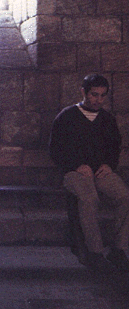
Overs:
Beyond Simon & Garfunkel
If you’re interested in the work of Paul and Art after S&G, here are some suggestions.

The abrupt ending of Simon & Garfunkel as a duo in 1970 in no way meant that Paul Simon and Art Garfunkel had finished their individual musical careers. Instead, both artists followed their divergent strengths and creative preferences into solo singing careers which would span across several decades. As a song writer with a growing interest in world music and rhythms, Simon’s work developed into a succession of upbeat, African influenced songs with high commercial appeal. Garfunkel’s strong, clear vocals and apparent interest in rich orchestration and arrangement caused him to gravitate towards traditional ballads and romantic standards. Today, Paul and Art continue to perform and produce new material to add to their long list of work. Even given these individual successes, however, Simon & Garfunkel as a duo were not entirely finished either. Paul and Art would come together many times after their initial separation, most recently in a very successful reunion tour.
ART GARFUNKEL
With the ending of Simon and Garfunkel, Art first turned to his acting career. Given his gifted vocal ability, however, there was little doubt that he would return to music and he produced several albums throughout the seventies, making a particularly successful pairing with song writer Jimmy Webb. After that period, he produced fewer and fewer full albums with the occasional project of special interest to him: a Christmas cantata, a children’s album, special appearances at events and on albums of artists such as the Chieftans. His international appeal has been even larger than in the US, however, and by the end of the nineties he was touring all over the world and making treks across continents while writing journals and poetry. Most recently, however, Art has fully returned to music with the release of an album in trio with two other artists, a great forum for new harmonies and musical styles, as well as the debut of his song-writing based on his poems and diaries.
For an excellent (and detailed) history of Art’s life and work visit www.artgarfunkel.com
If you are looking for an overview of Garfunkel’s music, you could try his early hits album Garfunkel (1981) but it does not really reflect the full range (or best) of Art’s work throughout the seventies in my opinion. It does offer an introduction to several important songs such as “All I Know” and “Break Away” that kind of defined his career from that era. His later retrospective album Up Til Now (1993) is odd in that it really doesn’t contain that much of Art’s album work as it does individual songs that he did for soundtracks and such throughout the late eighties and nineties. It does give a feel for his work around that period, however. There are also some newer songs and a live concert song written expressly for the artist.
That said, I would much more suggest listening to his individual early albums, starting with the excellent Angel Clare. Even though Paul had more fame, Art’s solo albums and other work is actually much more my favorite. You can find details about his albums and my thoughts on them by going to here
Non-compilation solo albums released by Art Garfunkel include:
Angel Clare
Breakaway
Watermark
Fate for Breakfast
Scissors Cut
The Animals’ Christmas
Lefty
Songs from a Parent to a Child
Everything Waits to Be Noticed (w/ Maia Sharp and Buddy Mondlock)
Some Enchanted Evening
PAUL SIMON
Not too surprisingly, Paul Simon’s post-S&G career stayed focused around his music and song-writing. He maintained continued success with a variety of albums in the seventies whose loose and sarcastic style captured the feelings of the time. He garnered even wider accolades for his African styled albums of the mid-eighties. More recently his work has both followed his interest in Africa (including his try at writing for Broadway called The Capeman) and a return to his focus on upbeat acoustic guitar tunes. While some of his more recent ventures have not been as commercially well-known, he has maintained his interests and love of writing.
For a good overview of Paul’s early solo work, I would recommend Negotiations and Love Songs, 1971-1986. This album offers the biggest hits of Paul Simon between the years of 1971 and 1986. (The majority of the songs come from the his work in the 1970’s, however.) Because the album does contain basically all the well-known successes that Paul had during that period, it is a very good buy if you enjoy songs like “Mother and Child Reunion”, “Loves Me Like a Rock”, and “50 Ways to Leave Your Lover” as well as the much later “You Can Call Me Al” but don’t want to buy all the separate albums on which they appear.
The list of Paul Simon (non-compilation) solo releases includes:
Paul Simon (1972)
There Goes Rhymin’ Simon (1973)
Still Crazy After All These Years (1975)
One-Trick Pony (1980)
Heart and Bones (1983)
Graceland (1986)
Rhythm of the Saints (1990)
Songs from the Capeman (1997)
You’re the One (2000)